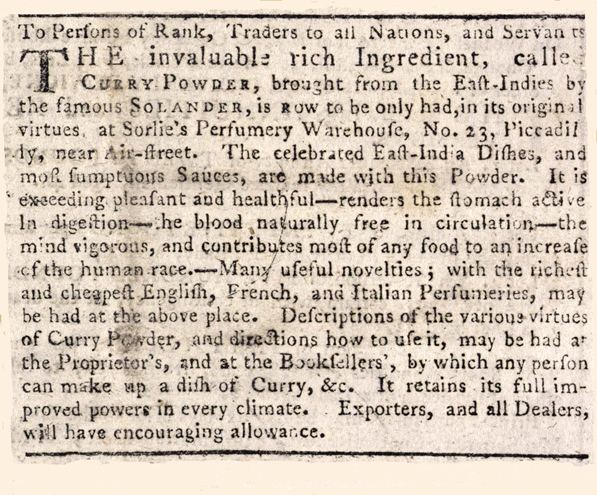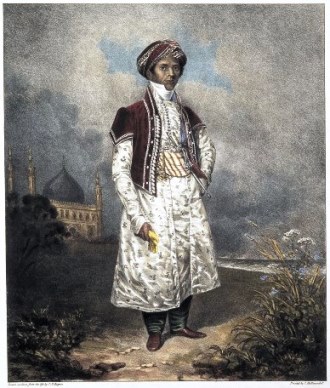Where did curry powder come from?
There is no real equivalent in authentic subcontinental cuisines for a ready-made powder. The closest thing to a curry powder is a masala, and that is almost always more of a paste than a powder because of the addition of wet and dry ingredients to the mix. On the subcontinent, seeds and roots, etc. are roasted, ground and mixed in varying proportions according to the needs of the recipe. Although the origins of curry powder are unclear, the advertisement below gives us a firm data point of the mid 1780s for a commercial curry powder for sale in London.

The advertisement, which ran in the Morning Post (now incorporated into the Daily Telegraph) says that this curry powder was brought back from the East Indies by Solander. Now, Solander was the great Swedish naturalist who was botanist on Captain Cook’s Endeavour expedition to the Pacific. Despite the claim, this is probably just a marketing ploy – like Mrs. Pepperidge – because the closest the Endeavour ever got to India was actually Indonesia (Batavia/Jakarta) and it returned to Britain in 1771, some 13 years before the advertisement. Solander, on the other hand, did meet an untimely death in 1784, and was something of a celebrated figure at the time. So, it was good business sense by the maker of the curry powder to use Solander’s name to conjure images of exploration and the exotic cuisines of the east.
It isn’t completely clear which company manufactured this powder, but I have one data point that indicates that it was Crosse and Blackwell – S&B – still makers of chutneys, relishes, and sauces. The problem with this is that they weren’t incorporated until 1830 when the men behind the initials S&B bought the business from its proprietors West and Wyatt. West and Wyatt, on the other opened its doors for business in 1706, so it indeed could have been their curry powder for sale at Sorlie’s Perfumery Warehouse in 1784.
The advertisement claims that the curry powder will help you make sumptuous sauces for East-Indian dishes. It also says that the curry powder promotes good digestion, good circulation, a vigorous mind and . . . wait for it . . . a strong libido. Who doesn’t want more of all that? How could anyone resist?

In 1773 the Norris Street Coffee House in Haymarket started selling a prepared curry, and by 1810, Sake Dean Mahomet opened the first Indian-owned and operated Indian restaurant in Britain with the Hindustan Coffee House at 34 George Street, Portman Square. In Mahomet’s restaurant, British patrons could enjoy hookahs with ‘real Chilim tobacco’ as well as a wide selection of curries.
Fortunately, perhaps, or not, this article has no firm conclusions to offer about the definitive origins of curry powder, but it does place some good data on the table. Despite my wanting to keep the door open to the contributions of Anglo-Asians in the formulation of curry powders, my instinct tells me that commercial, prepared curry powder is probably not their contribution to world cuisine. If it were an Asian or an Anglo-Asian invention, I would think that the taste of curries made with curry powder would be a lot more authentically “Indian”. Still, I’ll keep digging to see there are further strands to pull, so stay tuned. (Words by Laura Kelley, Newspaper clipping of first British Curry Powder Ad from the British Library and Portrait of Sake Dean Mohamet from the Wellcome Archive.)
